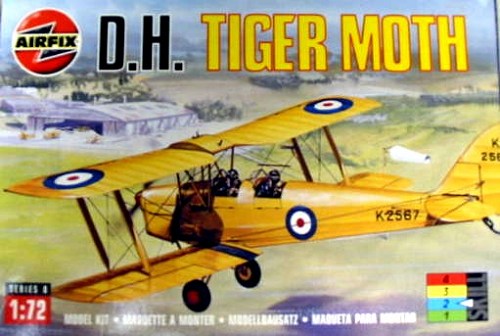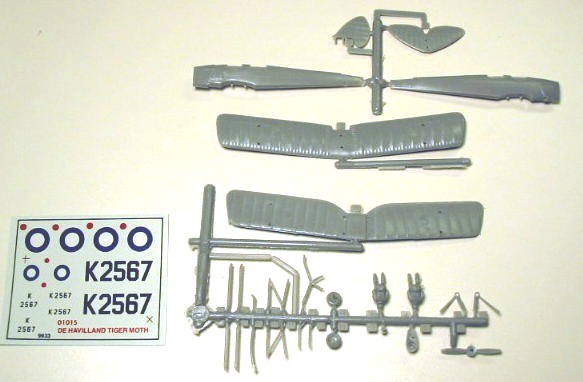
| KIT: | Airfix 1/72 Dehavilland Tiger Moth |
| KIT #: | ? |
| PRICE: | $5.00 when new |
| DECALS: | One Option |
| REVIEWER: | Bill Michaels |
| NOTES: |

| HISTORY |
The DH-60 Moth first flew in 1925, and was the start of a series of biplanes that evolved into the hugely successful DH-82. In 1931, the RAF requested a few changes to be made to the DH-60 design, and the resulting aircraft became the first DH-82 Tiger Moth. The Tiger Moth was soon adopted as the RAF’s primary trainer. The plane was also exported to 25 countries, and was also used by civilian flying schools and flying clubs.
Tigers were produced in Canada as well as in the UK, and production expanded greatly as demands for RAF pilots escalated. A number of Canadian aircraft were modified with enclosed canopies, a concession to the climate!
After the war ended, a large number of war-surplus Tigers were available, and they found their way into a number of flying clubs all over the world. Tigers were used as trainers, personal transports, aerobatic and airshow machines, and crop dusters. There were Tigers with wheels, Tigers with skis, and Tigers on floats. A couple were even converted to serve as ersatz “Fokkers” for the film “Lawrence of Arabia”, in 1961.
| THE KIT |
 This is another one of
Airfix’s older kits, I believe. I would describe it as typical Airfix-- a
relatively well done, simple model that looks like the prototype, with
limited detail. This is a simple model of a simple prototype— as with most
trainers, there isn’t much to the aircraft.
This is another one of
Airfix’s older kits, I believe. I would describe it as typical Airfix-- a
relatively well done, simple model that looks like the prototype, with
limited detail. This is a simple model of a simple prototype— as with most
trainers, there isn’t much to the aircraft.
My copy of the kit was molded in light grey plastic, which makes it a little unusual. Most copies of the kit I have seen were molded in bright yellow. Surface detailing consists of raised panel lines and rivets, and an engraved fabric effect. This is a small kit—there are only 25 parts.
The fuselage has limited raised panel, rivet and fabric detail. There is no interior detail at all. There are two pilot figures, and they have little plastic shelves to sit on. The figures are actually pretty good- a lot better than the figures that are in Airfix’s Swordfish for example. They are correctly proportioned, and have a reasonable amount of detail.
The top and bottom wings are each molded in one piece. Most kits of fabric covered aircraft from this period suffer from overdone rib effects on the wings, and this kit is true to the norm. While overdone, it is actually better than many kits, and it looks like it would be easy to subdue the effect with a little gentle sanding. Both wings suffer from large ejector pin marks that will need to be filled.
Parts are generally well molded, with a little bit of flash. If there’s going to be a problem area in this type of kit, it is usually the struts. The wing and landing gear struts in this kit look to be pretty well molded, a little oversize so they aren’t too brittle, but they are certainly not grossly oversize.
The instructions are minimal. They are printed on one side of a single sheet of paper. Assembly instructions are in the pictorial style, in four main steps. A brief aircraft history, and general instructions are printed in English, French, and German. You need to refer to the back of the box for decal and finishing information.
Assembly of this kit looks to be very simple, but, like any biplane, the top wing may be a challenge to mount. The cabane struts are molded as “N” struts, and the interplane struts are all individual pieces. The one piece cabane struts should make assembly easier- they set the top wing at the right amount of stagger. (Cabane struts are the struts that go from the fuselage to the top wing. Interplane struts are the ones that go between the wings.)
Every edition of this kit that I have seen over the years included decals to do an all-yellow RAF trainer. The small decal sheet offers markings for one aircraft, with basic markings only. No information is given about when or where the aircraft served. The decals in my kit looked pretty good, not too thick, with good color saturation and they are printed in register.
| CONCLUSIONS |
Cautiously Recommended. This is a simple model of a simple aircraft, but it is not a bad model. The difficulty associated with mounting the top wing may frustrate a beginner, though. This model compares favorably with many of the biplanes from Revell or Airfix from this era. Like many of its contemporaries, it could really benefit from some scratch built cockpit detail, if that’s your thing.
It is a shame that the kit only provides one decal option. There are many colorful options for “Tiggies”, from the various flying clubs and flying schools all over the world, in addition to all the military trainers. Fortunately, as least some decal makers have not forgotten the DH-82….
A quick “google” search turned up a several aftermarket decal sheets for the Tiggie. Some examples:
- A Portuguese Air Force DH-82 with a neat Tiger scheme.
- A Yugoslav museum’s DH-82.
- An all yellow “Kodak” scheme.
- Fictional markings for Herge’s “Adventures of Tintin”
- RCAF trainer
- Dutch AF trainer
- RAF trainer
- RAAF trainer
- RAN trainer
There are also sheets of generic civil registration letters, which could be used when doing any of the hundreds of civilian schemes.
| REFERENCES |
Aircraft in Profile, Volume 6: D.H.82 Tiger Moth, by A.J. Jackson
If you would like your product reviewed fairly and quickly by a site that has nearly 300,000 visitors a month, please contact me or see other details in the Note to Contributors.